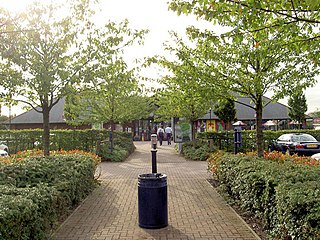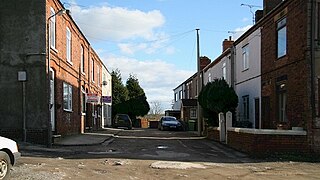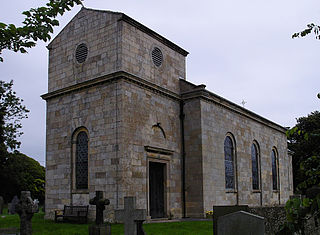
Pleasley is a village and civil parish with parts in both Derbyshire and Nottinghamshire. It lies between Chesterfield and Mansfield, 5 miles (8 km) south east of Bolsover, Derbyshire, England and 2.5 miles (4 km) north west of Mansfield, Nottinghamshire. The River Meden, which forms the county boundary in this area, runs through the village.

Bolsover District is a local government district in Derbyshire, England. It is named after the town of Bolsover, which is near the geographic centre of the district, but the council is based in the large village of Clowne to the north. The district also includes the town of Shirebrook and several villages and surrounding rural areas.

South Normanton is a village and civil parish in the Bolsover District of Derbyshire, England. The population at the 2011 Census was 9,445. An ex-mining village, it is two miles east of Alfreton. The historic industries of the village were agriculture, stocking, spinning and mining. Normanton means 'the farm of the north men' or 'Northwegans'.

Morton is a civil parish and village, three miles north of Alfreton in North East Derbyshire, Derbyshire, England. The civil parish population at the 2011 Census was 1,195.

Blackwell is a village in Derbyshire, England. The population of the civil parish at the 2011 census was 4,389. It is one of the four villages that make up the civil parish of Blackwell within the District of Bolsover - the other villages being Hilcote, Newton and Westhouses. The Parish Council meets monthly. A brief history of the Parish of Blackwell was published in 1994.

Tibshelf is a village and civil parish in the Bolsover District in Derbyshire, England. It lies between the towns of Clay Cross, Shirebrook, Mansfield and Chesterfield and had a population of 4,348 at the 2021 Census. Tibshelf shares its boundaries with the villages of Morton, Pilsley, Newton, Teversal and Hardstoft.

North Wingfield is a large village and civil parish in the North East Derbyshire district in the county of Derbyshire, England. Located approximately 4½ miles south-east of Chesterfield, and 1 mile north-east of Clay Cross. The population of the civil parish as of the 2022 census was 5,885. The A6175 road from the M1 motorway to the A61 road runs through the village.

Tibshelf services, opened in 1999, is a motorway service area operated by Roadchef between junctions 28 and 29 of the M1 motorway in Derbyshire, England. The site is near Tibshelf Ponds and the Five Pits Trail and lies around 2⁄3 mile (1.1 km) south-east of the village of Tibshelf, but the north-bound site is closer to the village of Newton. During the planning of the site it was originally named Chesterfield services, and during its archaeological evaluation Bronze Age flints and pottery were discovered - indicating the potential of Bronze Age enclosures in the surrounding area.

Pilsley is a village and civil parish in the district of North East Derbyshire in the county of Derbyshire, England, near the town of Chesterfield. At the 2011 Census the population was 3,487.

Elmton is a linear village and former civil parish, now in the parish of Elmton with Creswell in the Bolsover district of Derbyshire, England, approximately equidistant from Bolsover Castle and Creswell Crags. In 2011 the parish had a population of 5550. On 1 April 2014 the parish was abolished to form "Elmton with Creswell". However the pre 2014 parish had also sometimes been called "Elmton with Creswell".

Astwith is a village in Derbyshire, England. Astwith is in the parish of Ault Hucknall. For many decades it was a part of the manor of Stainsby, which was known as Steinesbei in the Domesday survey (1087).
Tibshelf Community School is a mixed secondary school located in Tibshelf in the English county of Derbyshire.

William Thomas Hulatt was an English athlete notable for finishing third behind Sir Christopher Chataway in the historic race in which Sir Roger Bannister ran the first sub-four-minute mile on 6 May 1954. He was from a working-class family and the only runner in the race who was not a university student.

The 2007 Bolsover District Council election took place on 3 May 2007 to elect members of Bolsover District Council in Derbyshire, England. The whole council was up for election and the Labour Party stayed in overall control of the council.

Shirland and Higham is a civil parish within the North East Derbyshire district, which is in the county of Derbyshire, England. Mainly built up with rural fringes, its population was 4,802 residents in the 2011 census. The parish is 120 miles (190 km) north west of London, 14 miles (23 km) north east of the county city of Derby, and 1+3⁄4 miles (2.8 km) north of the nearest market town of Alfreton. It shares a boundary with the parishes of Alfreton, Blackwell, Brackenfield, Morton, South Normanton, South Wingfield, Stretton, Tibshelf and Wessington.
The Hundreds of Derbyshire were the geographic divisions of the historic county of Derbyshire for administrative, military and judicial purposes. They were established in Derbyshire some time before the Norman conquest. In the Domesday Survey of 1086 AD the hundreds were called wapentakes. By 1273 the county was divided into 8 hundreds with some later combined, becoming 6 hundreds over the following centuries. The Local Government Act 1894 replaced hundreds with districts. Derbyshire is now divided into 8 administrative boroughs within the Derbyshire County Council area.
Blackwell is a civil parish in the Bolsover District of Derbyshire, England. The parish contains eight listed buildings that are recorded in the National Heritage List for England. Of these, one is listed at Grade II*, the middle of the three grades, and the others are at Grade II, the lowest grade. The parish contains the villages of Blackwell and Newton, and the surrounding area. The listed buildings consist of houses cottages and associated structures, farmhouses, a church, and a tombstone in the churchyard.



























